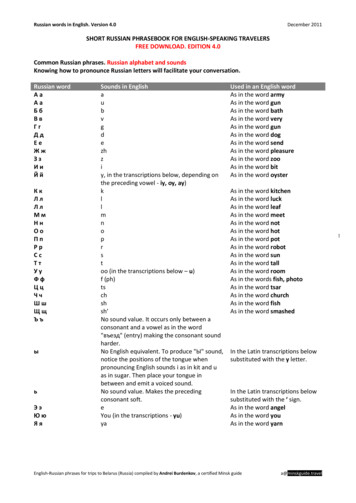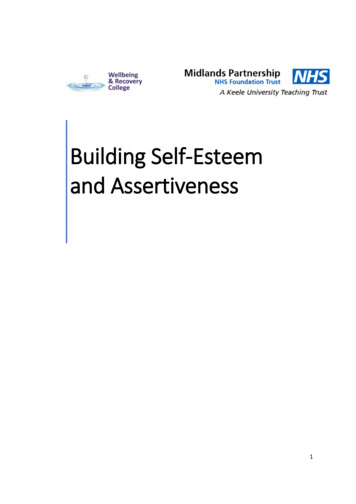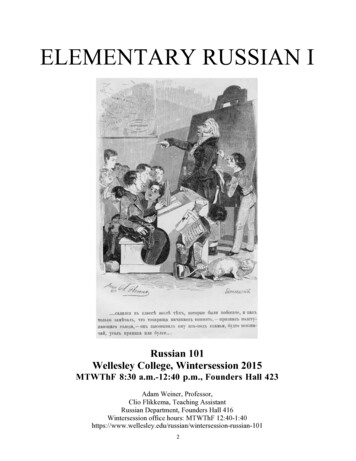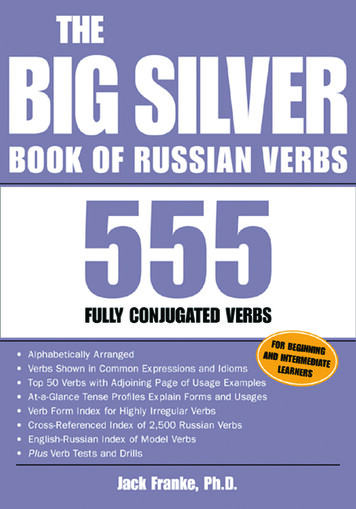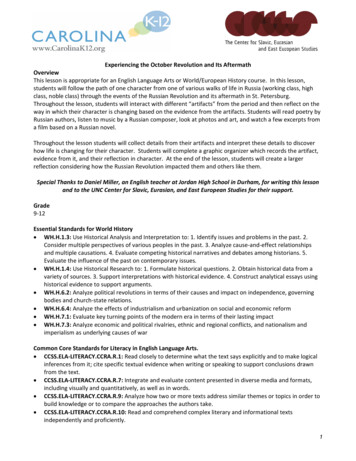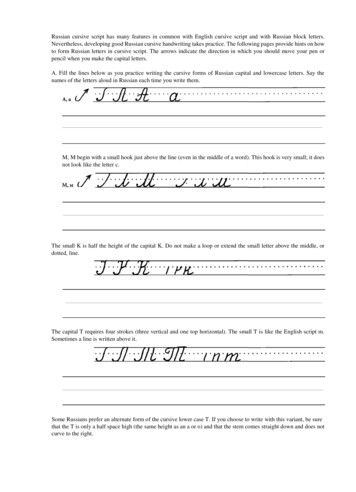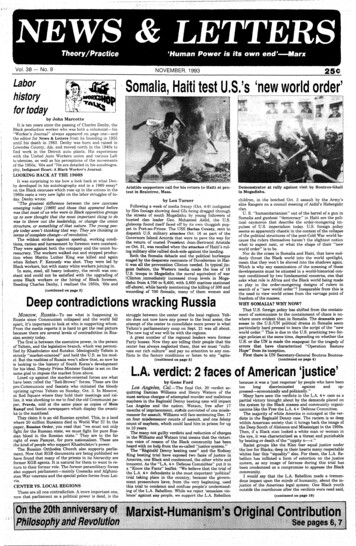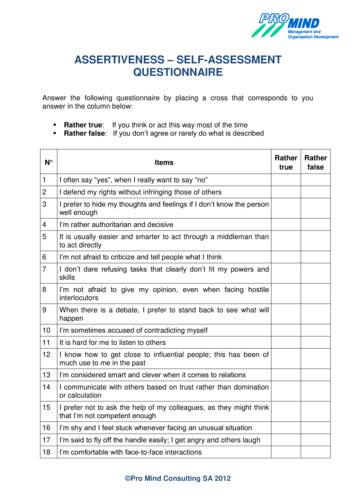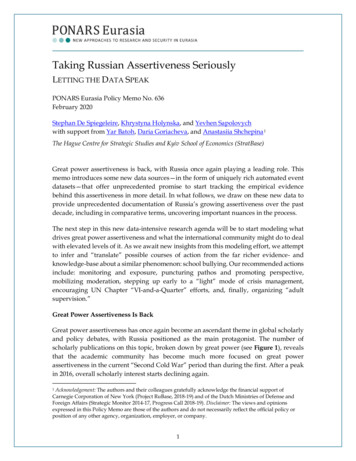
Transcription
Taking Russian Assertiveness SeriouslyLETTING THE DATA SPEAKPONARS Eurasia Policy Memo No. 636February 2020Stephan De Spiegeleire, Khrystyna Holynska, and Yevhen Sapolovychwith support from Yar Batoh, Daria Goriacheva, and Anastasiia Shchepina 1The Hague Centre for Strategic Studies and Kyiv School of Economics (StratBase)Great power assertiveness is back, with Russia once again playing a leading role. Thismemo introduces some new data sources—in the form of uniquely rich automated eventdatasets—that offer unprecedented promise to start tracking the empirical evidencebehind this assertiveness in more detail. In what follows, we draw on these new data toprovide unprecedented documentation of Russia’s growing assertiveness over the pastdecade, including in comparative terms, uncovering important nuances in the process.The next step in this new data-intensive research agenda will be to start modeling whatdrives great power assertiveness and what the international community might do to dealwith elevated levels of it. As we await new insights from this modeling effort, we attemptto infer and “translate” possible courses of action from the far richer evidence- andknowledge-base about a similar phenomenon: school bullying. Our recommended actionsinclude: monitoring and exposure, puncturing pathos and promoting perspective,mobilizing moderation, stepping up early to a “light” mode of crisis management,encouraging UN Chapter “VI-and-a-Quarter” efforts, and, finally, organizing “adultsupervision.”Great Power Assertiveness Is BackGreat power assertiveness has once again become an ascendant theme in global scholarlyand policy debates, with Russia positioned as the main protagonist. The number ofscholarly publications on this topic, broken down by great power (see Figure 1), revealsthat the academic community has become much more focused on great powerassertiveness in the current “Second Cold War” period than during the first. After a peakin 2016, overall scholarly interest starts declining again.1 Acknowledgement: The authors and their colleagues gratefully acknowledge the financial support ofCarnegie Corporation of New York (Project RuBase, 2018-19) and of the Dutch Ministries of Defense andForeign Affairs (Strategic Monitor 2014-17, Progress Call 2018-19). Disclaimer: The views and opinionsexpressed in this Policy Memo are those of the authors and do not necessarily reflect the official policy orposition of any other agency, organization, employer, or company.1
Figure 1: Breakdown of Great Power Assertiveness Studies by Subject Country,1951–2020 (Normalized by All Academic Publications in a Respective Year, Lens.org)Note: The (normalized) dataset visualized here was extracted from the largest free and open bibliographic database, TheLens, based on the following search query: abstract: (assertiv* OR aggress*) and Russia and (“foreign policy” OR“defense policy” OR “defence policy” OR “security policy”).The six great powers in the figure above include the world’s five largest economies today(in nominal terms) plus Russia, in light of its territorial size and continued (and resurgent)military, including nuclear weight. We also observe that Russia (in red) took over fromthe United States (in green) assertive dominance in the inter-cold-war period with the firstpeak in 2008 (the August war with Georgia), and then a much bigger and protracted peaksince 2014 (mostly events in Ukraine and Syria, but also cross-domain interference in othercountries). This was followed by a return to pre-2014 levels during 2018 and the first halfof 2019 (the attack in the Kerch Strait in November 2018 being the exception). It is strikingthat Russia plays a relatively bigger role than, for instance, China.What Do the Event Data Say?Against the background of increased scholarly attention, what do we actually know aboutthe reality of Russian assertiveness? This memo presents new data on this based on fourdifferent automated event datasets that, usefully, all use the same2 event coding scheme2 Despite this underlying similarity, they still differ so we filtered out only those patterns or trends that seemrobust across most of these datasets. For instance, they all use (quite) different sources, coders, dictionaries,deduplication methods, etc. For more, see Holynska et al., “Events Datasets and Strategic Monitoring,” TheHague Centre for Strategic Studies (forthcoming).2
(CAMEO), 3 which enables analysts to compare and analyze their findings: GDELT (bothEnglish and Translingual), ICEWS, and Terrier. 4This section reports some interesting recent findings on Russia’s factual negativeassertiveness, where factual refers to “real-life” (not rhetorical) events and negative meansconflictual assertiveness. An example of such assertiveness would be an event with Russiaas the source actor, the event code “Fight with artillery or tanks” (making it a factual,negative, and assertive event), and any target actor (for example, Ukraine). 5We use two main metrics in our visuals. The first one is quantitative. It measures thenumber of reported Russia-initiated internationally assertive events as a percentage of allinter-state events. 6 A higher proportion of reported events in this category suggestsincreased assertiveness. The second metric is more of a qualitative nature. It is based onthe so-called Goldstein scale, which assigns every event code a score from -10 (such as amilitary attack, clash, or assault) to 10 (such as a military retreat or surrender).Averaging these Goldstein scores per country per month allows us to gauge whetherRussia’s assertiveness is mellowing (if the score goes up) or hardening (if it turnsdownwards). The nature of the event codes also allows us to differentiate between factualand verbal events, as well as between diplomatic, economic, and military ones. Figure 2below contains the data for Russia’s factual negative assertiveness during this decade asrecorded in the four event datasets.Philip A. Schrodt, “CAMEO: Conflict and Mediation Event Observations Event and Actor Codebook,”Event Data Project, Department of Political Science, Pennsylvania State University, 2012.4 TERRIER (Temporally Extended, Regular, Reproducible International Event Records) is a machine-codedevent dataset built on all news reports available in the Lexis-Nexis data service from 1980 to 2015 andproduced by a team at the University of Oklahoma as part of the NSF RIDIR grant “Modernizing PoliticalEvent Data” SBE-SMA-1539302.5 The “negative” type of assertiveness is based on the so-called “quad score” used in the CAMEO ontology(Schrodt, “CAMEO.”) which identifies every event in a binary way as either conflictual or cooperative aswell as either factual or verbal.6 This normalization is required in light of the greatly increased number of publications that are coveredin—especially—a dataset like GDELT33
Figure 2: Russia’s Factual Negative Assertiveness, 2010-2019(Normalized by All Inter-State World Events)Note: We do not include the Phoenix dataset as its coverage is too patchy for this decade.Most of the event datasets concur that both the quantity and the quality of Russia’sinternational assertiveness have taken a turn for the worse over the past decade (moreassertive events with more negative scores). They also show, a point that may be lesswidely appreciated, a marked (again, both quantitative and qualitative) decline in thisassertiveness in the past year, returning the country to its pre-2014 assertiveness level.If we compare the data on Russia with the equivalent data for other great powers, we seethat Russia, the United States, and the United States’ European allies have militarily beenthe most assertive geopolitical actors (see Figure 3). While the events involving all greatpowers tend to have low average Goldstein scores, the quantity of normalized events forthese actors is the highest.4
Figure 3: Comparative Negative Factual Military Assertiveness of the Great Powers,2010-2019 (Normalized by All Inter-State World Events)Event datasets allow for an even deeper dive into assertive events by functionalcategories. Figure 4 shows the breakdown of Russia’s negative factual assertiveness intodiplomatic, economic, and military categories.5
Figure 4: Russia’s Overall Factual Negative Assertiveness by DISMEL, 2010-2019(Normalized by All Inter-State World Events)This figure clearly shows that the military domain has played a dominant role in theRussian assertiveness story over the past decade, with particularly notable peaks relatedto events in Ukraine and Syria. Russian assertiveness in the diplomatic (and even more soin the economic) domain remains significantly more subdued, except for a peak in March2018 related to the Skripal affair and the tit-for-tat expulsion of Western diplomats.We can also disaggregate the data dyadically to find out which countries have been thepreferred targets of Russian assertiveness. We observe that in all datasets, the UnitedStates, Ukraine, and Syria have been Russia’s top targets throughout this decade. In allthese cases, military assertiveness prevailed over all other types of assertiveness.6
Figure 5: Top-10 Targets of Russian Negative Factual Assertiveness, 2010-2019(by Dataset; Normalized as % of All Negative Factual Assertive Events Where Russia is the Source Actor)The dyadic Russia-United States data in Figure 6 (below) suggest a decrease in the numberof Russia’s assertive events since the start of the Trump administration as well as a lessnegative tone. Military events have also played a much less dominant role in Russia’sreported behavior towards the United States than towards other top-targeted countries.7
Figure 6: Russia’s Factual Negative Assertiveness Toward the United States,2010-2019 (Normalized by All Inter-State World Events)How to Deal with Russia’s Assertiveness?This section offers a few attempts to translate findings from an analogous field with amuch stronger empirical base—school bullying—into possible courses of action that ourMinistries of Foreign Affairs and our defense and security organizations might want totake into consideration.Monitor and expose dangerous great power assertivenessGiven the unique role that great powers play in world affairs and the escalatory dangersthat lurk behind various forms of (especially military) assertiveness, any effective strategyfor dealing with great power assertiveness requires a fine-tuned sensing mechanism thatallows the international community to ring the alarm bell as soon as certain observablethresholds are crossed. Our own attempts at monitoring great power assertiveness8
suggest that it is increasingly possible to flag “excessive” brinkmanship based on detailedevidence. Authoritative international organizations such as the World Bank, IMF, WTO,and OECD already perform analogous international monitoring work in areas likeeconomic, education, health, trade policy, etc. It seems unlikely that our currentinternational security organizations (NATO, OSCE, African Union, UN, etc.) would bewilling to assume such a role. It may prove possible, however for our epistemiccommunity to team up to provide the international community with such a capability—not primarily to “name and shame,” but to let the facts speak for themselves.Puncture pathos and promote perspectiveNegative assertive behavior is regularly couched in emotional verbiage about pastendured injustices, unfair treatment, misunderstood actions, and the like. Whether suchallegations are legitimate or not can only be established by disassembling them into factand fiction with surgical precision. If the international community wants to make progressin this area, it stands to reason that it will have to find more reliably neutral ways topuncture such pathos with facts and figures—also toward the societies on all sides thatare subjected to various distorted or one-sided narratives. This may again be an areawhere dispassionate epistemic communities from various countries could play a uniquelypositive role.Mobilize moderationMost societies (like individuals) carry in themselves the seeds of both moderation andexcess. Societies that are being swept up by internal or external political entrepreneursinto bouts of jingoistic fervor typically still contain silent majorities that simply condoneor go along with these excesses (as well as smaller groups that might actively resist it). Inthis day and age of global connectivity, it is more possible than ever before to reach andempower the healthy fibers of societal resilience that are embedded in those groups oreven individuals.Step up early to a “light” mode of crisis managementAs the educational “assertiveness” literature suggests, interventions need to target thebully at multiple levels, addressing the overall—social or otherwise—context in which thebully operates, directly taking the bully on and trying to change their incentive structure.Firm sanctions are not to be shied away from. In the realm of international relations, thismeans that one should consider aggressive assertive behavior as a first step on a crisisescalation ladder. This recognition implies that one should start by applying crisismanagement procedures and techniques. However, stepping up into a crisis managementmode should be seen as a flexible, smooth, and unobtrusive process, and not as anassertive, escalatory move in itself (hence the word “light”).Energize UN Chapter “VI-and-a-quarter” effortsThe international community currently does not have the wherewithal to take a firm standagainst assertiveness. It can—and often does—condemn certain actions by great powers.9
But the debilitating Security Council veto powers held by some of the very same greatpowers that our data show to be among the worst “culprits” mean that such words arevirtually doomed to remain idle. The UN Charter currently includes only Chapter VI—the peaceful resolution of disputes by diplomatic or judicial means—and Chapter VII—peace enforcement related to military operations. Over the past few decades, however, theterm “Chapter VI-and-a-Half” has become popular as a “solution” situated between UNChapters VI and VII. It was coined by former UN Secretary General Dag Hammarskjöldto cover the numerous and quite successful peacekeeping operations that had been carriedout under the UN flag. Would it be conceivable to also start thinking about a Chapter “VIand-a-Quarter” whereby the United Nations, once an ascertained level of assertiveness bya great power crosses a certain predefined threshold, could step up its resolution efforts?Organize “adult supervision”All major (and not-so-major) players in the international system—including privatecompanies, NGOs, cities, etc.—are affected by growing great power assertiveness. Giventhe widely acknowledged limitations of present-day international global governance, thebroader international community might be triggered to develop a number ofcomplementary mechanisms to deal with this. Could it, for instance, be conceivable thatsome of them would organize a global solutions network, around great powerassertiveness that would “clinically” monitor behavior, dissect rhetoric, “target” silentmajorities, and identify possible ways out of impasses? Defense and securityorganizations—perhaps especially in small- and medium-sized countries—might be ableto play a catalytic role in this development as the responsible custodians of the broaderdefense and security ecosystem.ConclusionsWe once again—against widespread prior expectations—find ourselves in an age of greatpower assertiveness, in which Russia plays an important role. Our empirical andtheoretical knowledge about this type of international behavior and the geodynamics thatsurround it remains disappointingly limited. Current-day Russia, which in its previousincarnation as the Soviet Union was one of the most intensely and thoroughly investigatedsubjects in the international arena, is no exception to this unfortunate state of affairs. Thecountry’s behavior keeps surprising the international community and there is littleevidence that we have made any real progress on this score.Our decidedly suboptimal understanding of Russia as a society, as a polity, as aneconomy, and as an international actor is further exacerbated by the quite idiosyncraticway in which “foreign and security policy analysis” is conducted—certainly whencompared to other more mainstream forms of public policy analysis. The very basiccommon-sense precepts of this discipline are routinely flaunted and/or ignored in thefield of foreign policy analysis. That is certainly the case with respect to the careful10
systematic collection of empirical evidence, but also to the modeling, option and criteriageneration, trade-off adjudication, and communication efforts that build on it.This nefarious combination of suboptimal situational awareness/understanding andunderdeveloped policy analysis mechanisms bodes ill for policy-making. And yet, thereare some encouraging developments as well. New scientific/technologicaldevelopments—primarily in the fields of natural language processing, natural languageunderstanding, and machine learning—offer unprecedented promise on both fronts. Thismemo illustrates some of the new insights that one (early) example of this technologicalconfluence—event datasets—is likely to bring to field studies.Truly new approaches to (also Russian) security policy analysis are sorely needed.Suggested here are three of these.1. Construct a more granular evidence- and knowledge-base for the variousmanifestations of Russian foreign and security policy thinking and acting, as wellas for other actors’ thoughts and behaviors. Without this, any real analysis of thecomplex underlying dynamics will be impossible.2. Better align foreign and security policy analysis with the more mainstream(public) policy analysis field.3.Broaden our scientific aperture toward more synoptic analyses that also try tolearn from other fields—both in terms of phenomenological analysis of what ishappening and how to understand it but also of what it means for our policyoptions.The HCSS-Georgia Tech RuBase team is available to engage with colleagues who are interested in exploringthe promise and peril of data-intensive science for the analysis of Russian foreign and security policy.11
Appendix: What Do the Event Data Not (Yet) Say?Having illustrated some of the findings the event datasets can already provide us with, itis also important to highlight the limits of what we are currently able to achieve. First, thesedatasets’ quality needs to be further improved. Current funding levels coupled with thevertiginous breakthroughs in NLP/NLU seem to guarantee that their quality will continueto increase significantly. It remains an open question whether region- and/or domainspecific human, automated, and mixed coding efforts will allow us to improve the qualityof the “generalist” NLP-coders. HCSS and Georgia Tech have obtained funding for at leastthe next three years to further explore this avenue—especially for Russia. Various otheranalogous large-scale research projects are also underway along similar lines.Secondly, event datasets do not help us in absorbing and making sense of one of the richestdatasets: (academic, more broadly scholarly, policy, etc.) text-based documents. Eventextraction is only one of the many forms of semantic entity and relationship extraction thatare mushrooming in the fields of NLP/NLU. Here too, region-/domain- specific efforts willbe required, including in the field of Russian foreign and security policy analysis. Creatingand validating ‘gold corpora’ models, on which machine learning can be trained, is anextremely labor-intensive effort that is now only getting off the ground in our area. To besuccessful, this will require novel forms of collaboration from a field that is bibliometricallydemonstrably quite uncooperative.Thirdly and most importantly, the major challenge will then be to store and curate all ofthat generated and extracted data, information and knowledge in “live” knowledgebases—and increasingly knowledge graphs—that will finally offer us a chance to start bothdeductively identifying and testing (much broader) hypotheses across much richerempirical and semantic-conceptual datasets, but also to start inductively detecting possiblerobust patterns and trends that require further investigation. Most of us realize that, in“International Relations Theory” terms, both first- (individual, e.g., Putin), second(societal and domestic-political), and third- (systemic but also geodynamic) level variablesmatter to Russian security policy and that to truly understand the way in which theseintersect to produce Russian international behavior will require a different researchapproach from the one we have pursuing for (at least) the past few decades.The bad news here is that our empirical and theoretical knowledge about great powerassertiveness remains limited. Foreign and security policy analysis remains quite farremoved from mainstream policy analysis which puts systematic evidence center front. Thegood news is that help is on the way in the form of rapid developments in natural languageprocessing/understanding and machine learning tools that will start generating more andbetter policy-relevant evidence and knowledge. PONARS Eurasia 2020. The statements made and views expressed are solelythe responsibility of the author. PONARS Eurasia is an international networkof scholars advancing new approaches to research on security, politics,economics, and society in Russia and Eurasia. PONARS Eurasia is based at theInstitute for European, Russian and Eurasian Studies (IERES) at the GeorgeWashington University’s Elliott School of International Affairs. Thispublication was made possible in part by a grant from Carnegie Corporationof New York. www.ponarseurasia.org12
behind this assertiveness in more detail. In what follows, we draw on these new data to provide unprecedented documentation of Russia's growing assertiveness over the past decade, including in comparative terms, uncovering important nuances in the process. The next step in this new data-intensive research agenda will be to start modeling what
